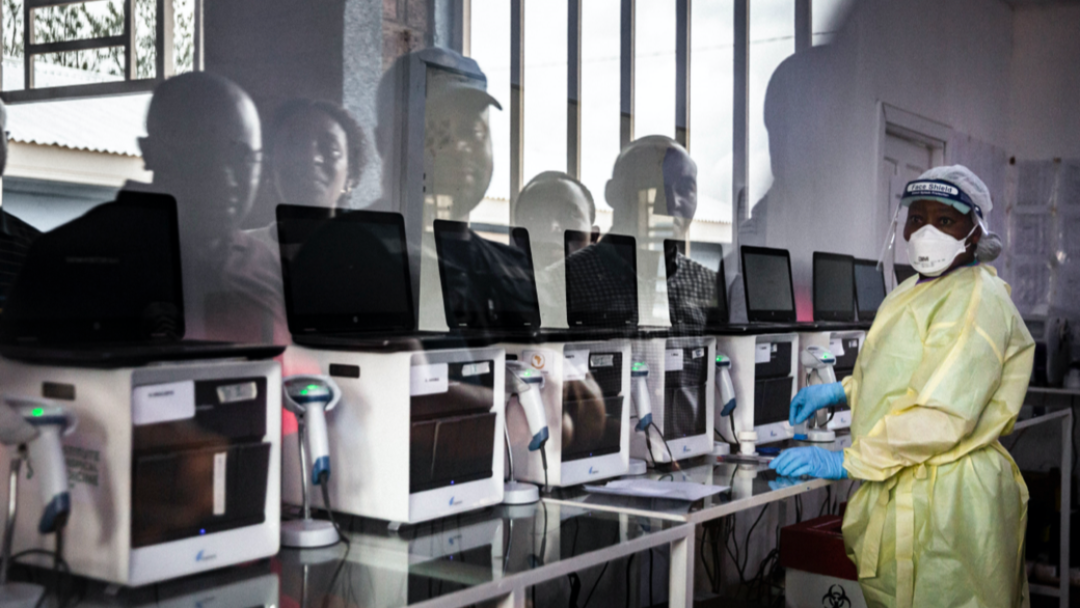Tip: Activate javascript to be able to use all functions of our website
No. 10, April 2020 Authors and editors: Dorothea Kolb, Vivien Mohrland, Franziska Grimm, Christian Schönhofen
Lessons learned from evaluations can substantiate FC responses to the coronavirus crisisEarly response is the most important component for a succesful contamination of epidemics and crises. This is the result of analyses from Ebola projects: the costs of late responses are hard to quantify, but studies have suggested that half the caseload could have been avoided – equivalent to thousands of lives saved – if the Ebola response had arrived one month earlier [1]. FC evaluation experience teaches us that an “early response” does not always succeed; measures come too late or the crisis develops unexpectedly, so that restructuring becomes necessary [2], and ADB also mentions this problem: “design rapidly but mindful of quality at entry” [3]. Even in crises that could have been foreseen at an earlier stage (e.g. the food crisis in the Horn of Africa), it became apparent that the international response was slow and, as a result, inefficient and expensive (14th Evaluation Report).
When developing additional FC projects, lead time (also in the case of emergency projects, compliance with national regulations is a must) and the expected stage of the pandemic at the time of implementation should therefore be taken into account. Where a swift response is required, it is important to ensure effective interaction between humanitarian aid and development cooperation, and to consider cooperation with established (UN) institutions.
Flexible and harmonised financing is useful when circumstances are dynamic and unpredictable. Policy-based financing can do this in the form of budget financing. An existing synthesis of evaluations stresses that a high degree of alignment is necessary and that donors should collaborate as much as possible. Alternatively, co-financing structures using multilateral organisations and non-earmarked funds is an effective and efficient instrument to ensure needs-based measures in dynamic intervention contexts. In the case of emergency food aid, earmarking for certain components, regions or target groups had a negative impact on the evaluation of relevance and allocation efficiency (WFP emergency food assistance cooperation). When the civil war escalated in Yemen in 2015, non-earmarked FC funds could be directed to the WFP on short notice, thereby enabling rapid general food distribution – to all Yemenis without any exclusions (preliminary evaluation result).
In response to the Ebola crisis, various institutions poured into the affected countries. This overwhelmed national ministries, as was the case in Liberia, for example. The FC evaluations generally attest to the positive effects of co-financing. An urgent appeal for global cooperation in response to COVID-19 has also come from the German Development Institute [4].
Ownership is key to success and sustainability; however, it remains often unclear who takes the risk. Evaluations concerning the response to the Ebola crisis showed that overwhelmed national governments were unclear about who was in charge: national governments, WHO or donors? [5] Broad institutional support is needed to raise awareness among national stakeholders that pandemic response measures contribute to a global public good [6].
Targeting is often impeded by weak data and lower priority monitoring. Population density increases the risk of infection, but migration also presents challenges for controlling infectious diseases – migrants should, hence, be explicitly considered in the design process. Monitoring the measures over the course of the project is important to be able to make adjustments and identify best practices. Targeting can be supported by analysing digital data.
Community-based approaches are rated as highly important by a large number of evaluation studies. Close cooperation with local stakeholders and (local) policymakers helps to identify the urgency for immediate support and take the appropriate action [7]. Communication adapted to the respective local and cultural context, and the involvement of local leaders (be they religious leaders, heads of clan structures or local authorities) are important factors in a project’s success. For example, involving local structures in the efforts to combat the Ebola crisis is highlighted by the ADB as a crucial lesson learned [8].
“Do no harm” is an important guiding principle when planning projects in conflict and disaster situations. It relies on vulnerability analyses which take into account not only health provision but also the economic situation and existing lines of conflict, especially – and to ensure that no one is left behind – the needs of vulnerable groups (e.g. internally displaced persons – IDPs)).
Following the experience from the Ebola crisis FC implementing partners such as UN/INGOs may be exposed to greater risks, e.g. through increased access restrictions, but also because they become targets of hostility, propaganda and even attacks. Humanitarian aid and development cooperation should avoid strengthening the position of selected conflict parties that changes the power structures. For a conflict-sensitive response to natural disasters, evaluations of tsunami projects from Southeast Asia provide some.
Promising starting points are (i) the involvement of local authorities, (ii) transparent, fair and confidence-building allocation structures, (iii) coordinated and joint information campaigns and (iv) accompanying measures to enhance transparency and accountability.
Expected cost increases in crisis situations should be anticipated at an early stage to ensure that efficient and needs-based crisis management services can be offered and calculations can be adjusted.
As a result of the crisis national and global infrastructure often only functions to a limited extent, resulting in supply chain bottlenecks with higher prices for food and consumer goods and greater suffering by those affected by the crisis. For example, in 2015, the WFP’s programme implementation costs for food aid in Yemen were significantly higher than in previous projects due to the escalation of the civil war. The main reason was the increased cost of fuel and food. Speculation did not drive up prices during the 2008 food crisis only.

In the health sector, prevention is an established approach: (i) through education and (ii) vaccination campaigns. At the moment, education and symptomatic treatment are the only options; hopefully, a vaccine will be available in the medium term.
Experience stemming from HIV and family planning campaings offers valuable insights into prevention through education on modes of transmission, protection options and risks: social marketing agencies can create content suitable for the context, can draw on public confidence and complement government structures. Community-based approaches have proven effective in promoting hygiene awareness (see WASH [9] ) [10]. Existing structures can be quickly expanded. Education and hygiene remain essential even where tests and treatments are available, as these are (usually) not universally accessible. Despite treatment, prevention must not be disregarded, as is unfortunately often the case with HIV/AIDS. When developing testing capacities in tuberculosis programmes in Central Asia, the safety of medical staff and laboratories, as well as the logistics of sample transport, have proven to be important.
In addition to treating and caring for infected patients, providing additional beds for treatment also helps prevent further transmission, as a study on Ebola in Sierra Leone has shown [11].
As soon as it becomes likely that a vaccine will be approved, the focus will be on vaccination programmes, in addition to prevention. The keys to success in the FC polio projects under the Global Polio Eradication Initiative in India and Nigeria have been trust, monitoring and, if appropriate, adaptation, as well as the involvement of all key stakeholders and contextualisation.
The vertical programmes, which were initially driven largely by the international community, had little spill-over effect on the national health system, and large-scale immunisation campaigns need to be implemented with care to ensure that general vaccination and health programmes are not negatively affected, as was the case in India due to a lack of vaccination personnel.
These displacement effects also occurred in West Africa, where efforts to combat malaria suffered from the prioritisation of Ebola [12]. For routine immunisation, for example, the bilateral contribution to the multilateral organisation Gavi, the Vaccine Alliance in cooperation with UNICEF in Tanzania has proven to be effective and efficient.
Regardless of the stage of the pandemic response, maintaining basic electricity, water supply and sanitation plays an important role. The structures that are needed to fight the pandemic depend on this basic infrastructure. In addition, interruptions in water and sanitation services can lead to further health problems among the population (even to further epidemics such as cholera or dysentery) and thus put even more pressure on an already strained health system. Furthermore, stricter hygiene measures potentially increase water demand. A decentralised approach – i.e. assessing needs at the level of local supply facilities – has proven effective in eliminating supply bottlenecks typical of crises (e.g. fuel and spare parts) to ensure that aid can be provided as quickly and effectively as possible (e.g. EPE 2019, Emergency Crisis Programme in Yemen).
Social protection measures can also be a starting point for FC to mitigate the effects of a crisis. In this context, we can contribute FC evaluation experience with various transfer mechanisms in the area of food security. Cash and vouchers to purchase food (instead of food distribution) offer the target group more freedom to choose, which has a positive impact on the diversity of food consumed and strengthens empowerment in purchasing choices (example Yemen Basic Nutrition I + I| and UN funding in the Middle East). Cost efficiency also increases compared to food distribution, the logistics of which are quite costly. Besides these short-term solutions, structural measures such as cash-for-work, cash-for-assets or food-for-training offer more sustainable approaches. These schemes are designed to enable the target group to meet their food needs on their own.
Microinsurance systems can reduce the financial burdens of individuals in the event of illness. Cost coverage and sustainability of the supported systems are always important (e.g. evaluation of health financing Pakistan).
The effects of the Covid-19 pandemic are multi-sectoral, both in Germany and in developing countries, and therefore necessitate efforts in all development-relevant sectors to increase the resilience of partner countries to absorb future shocks as well.

[1] Clarke/Dercon (2016): Dull Disasters? How planning ahead will make a difference. Oxford University Press, p. 32.
[2] Preliminary finding from an ongoing evaluation of an Ebola project in Liberia.
[3] ADB (2020): Responding to the novel Coronavirus crisis: 13 Lessons from Evaluation, p. 3.
[4] DIE (2020): Lessons for Global Cooperation from the COVID-19 Pandemic.
[5] Clarke/Dercon (2016 ): p. 17/18.
[6] ADB (2020): Responding to the novel Coronavirus crisis: 13 Lessons from Evaluation.
[7] GIZ (2017): Lessons for the Future: What East African experts learned from fighting the Ebola epidemic in West Africa – A regional conference with international participation held in Nairobi, Kenya from 6th to 8th November 2017.
[8] ADB (2020).
[9] Yates et al. (2017): WASH interventions in disease outbreak response. Humanitarian Evidence Programme. Oxford: Oxfam GB.
[10] 3ie (2017): Promoting Handwashing and Sanitation behavior change in low- and middle-income countries: A mixed method systematic review.
[11] Kucharski et al. (2015): Measuring the impact of Ebola control measures in Sierra Leone. Proceedings of the National Academy of Sciences , 112 (46), p. 14366–14371 / ACAPS (2015): Briefing paper: Ebola in West Africa – impact on health systems, 26 February 2015.
[12] Walker, P. G., M. T. White, J. T. Griffin, et al. (2015): “Malaria morbidity and mortality in Ebola-affected countries caused by decreased health-care capacity and the potential effect of mitigation strategies: A modelling analysis.” Lancet Infectious Diseases 15(7): 825–32.